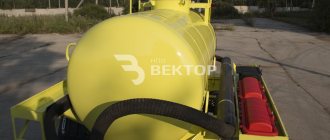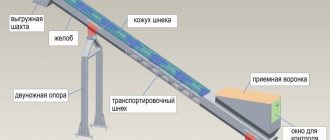500 thousand rubles is the maximum fine for organizations for incorrect transportation of large cargo. The government has established clear rules on how to organize it and not create a threat to road safety. Let's look at it:
- What is oversized cargo
- Rules for the transportation of oversized cargo
- Permit for transportation of oversized cargo
- How long does it take to obtain a permit?
- Why may they refuse to issue a special permit?
- Fine for oversized cargo
- Appealing a fine for oversized cargo
- Is it possible to pay a fine for oversized cargo at a discount?
What is oversized cargo
The cargo is considered oversized if its weight and volume exceed the standard permitted parameters. In other words, this is an object that does not fit in a standard body and poses a safety hazard to other road users. Most often this is special equipment or its parts, tanks, building materials, gas turbines, quarry equipment - something that cannot be disassembled into parts.
Oversized cargo is divided into heavy and bulky. Let's consider their features.
Heavy cargo - its weight together with the mass of the vehicle exceeds the following standards:
In addition to the number of axles, their location, permissible axle load and type of road are also taken into account. These standards are spelled out in detail in Appendices No. 2 and No. 3 to the Rules for the transportation of goods by road.
Oversized cargo - its volume exceeds the permissible values:
- 4 meters high;
- 12 meters in length for a single vehicle or trailer and 20 meters for a road train;
- 2.55 meters wide (for refrigerated trailers - 2.6 meters);
- 2 meters is the length of the load protruding from the rear beyond the dimensions of the vehicle.
Load height is measured from the road surface to the highest point of the transport structure.
If the cargo protrudes beyond the front and rear dimensions by more than 1 meter or from the side by more than 40 cm, a “Large Load” sign must be attached to it. In the dark and in poor visibility conditions, additionally equip them with flashlights or reflectors: white on the front, red on the back. Such norms are defined in clause 23.4 of the traffic rules.
Sign "Large cargo"
We talked in more detail about overload transportation in the article.
Road sign height restriction
The sign itself indicates the numerical value of the maximum height. The calculation of permissible values is carried out by specialists taking into account a certain additional margin, the value of which can reach forty centimeters. Such a reserve is important because over time, roads need repair work; accordingly, a new road surface can be laid, following such actions the total value between the structure and the road is reduced by several centimeters.
If you ignore the requirements of this sign, if a car whose size exceeds the permissible standards passes under certain engineering structures, it will not be possible to avoid disastrous consequences. In particular, heavy trucks can damage the structures themselves, followed by other unforeseen troubles. Due to structural destruction, if the car touched and damaged crossings over the road, created specifically for the safe movement of citizens. If these parameters are exceeded, video surveillance systems and lighting devices may fail.
Rules for the transportation of oversized cargo
If the cargo is considered oversized, carriers are required to arrange for its transportation according to the rules. They are installed:
- Traffic rules of the Russian Federation;
- Charter of road transport and urban ground electric transport;
- Decree of the Government of the Russian Federation dated December 21, 2020 No. 2200 “On approval of the Rules for the transportation of goods by road and on amendments to paragraph 2.1.1 of the Road Traffic Rules of the Russian Federation”;
- The procedure for issuing a special permit for the movement of a vehicle transporting heavy and (or) large-sized cargo on roads;
- Requirements for organizing the movement of heavy and (or) large vehicles on roads.
The Russian Federation Traffic Regulations determine the rules for the transportation of goods. According to clause 23.3, cargo can be transported if it:
- Does not restrict the driver's view.
- Does not complicate control and does not affect the stability of the vehicle.
- Does not cover lighting devices, retroreflectors, registration and identification marks. Otherwise - prosecution under Article 12.2 of the Code of Administrative Offenses of the Russian Federation.
- Does not interfere with the perception of hand signals.
- Does not create noise, does not generate dust, does not pollute the road or the environment. For violation - a fine under Article 12.33 of the Code of Administrative Offenses of the Russian Federation. For citizens - from 5,000 to 10,000 rubles; for officials - 25,000 rubles; for legal entities - 300,000 rubles.
If the dimensions of a loaded vehicle exceed the norm by more than 2%, its route must be agreed with the traffic police. It is prohibited to deviate from the traffic pattern. You can stop for rest only in specially designated parking areas, as well as outside special parking areas outside the roadway.
The speed of movement of vehicles with oversized cargo is set by federal or regional executive authorities, local governments or road owners, depending on which roads the route takes - federal, regional, city, rural or private (Order of the Ministry of Transport of Russia dated 08/31/2020 N 343). The intensity of traffic on the roads, travel time, weather conditions, and the nature of the cargo are also taken into account.
When coordinating the route, the traffic police will also determine whether the heavy truck requires escort.
Approximate view of the escort vehicle
Cover vehicles are required to be used if the permitting documents provide for the possibility of promptly changing the traffic pattern on certain sections of the route. Usually these are tunnels, bridges, areas with reverse traffic - where it may be necessary to suspend the movement of other traffic. This task will be performed by cover vehicles.
Depending on the size of the loaded vehicle, it may be accompanied by 2 or 3 cover vehicles (Order of the Ministry of Transport dated August 31, 2020 No. 343):
By decision of the traffic police, a police patrol can also accompany oversized cargo.
The general procedure for transporting oversized cargo and its escort is controlled by Rosavtodor. Therefore, the carrier organizing the delivery of oversized items must obtain permission from this department.
Check fines for overloading
Dimensions that have dimensional transportation objects
Dimensions of transported cargo (maximum permissible):
- width – 2.65 m;
- length – 22 m;
- height – 4 m;
- vehicle weight – 38–40 tons.
Permitted height of transported cargo
Permit for transportation of oversized cargo
If the weight of the vehicle with or without cargo and/or the axle load exceeds 2% of the established standards, large cargo can only be transported with a special permit. It must be obtained in advance from Rosavtodor of the region where the route begins.
Sample permit for the transportation of heavy and bulky cargo
To obtain a permit, you need to submit an application - in person at the regional Rosavtodor, by mail or electronically through State Services. The application shall indicate:
- information about the owner of the vehicle (full name, INN and OGRN for legal entities)
- route
- the number of trips and their duration;
- characteristics of the cargo (name, dimensions, weight, divisibility);
- make, model, license plate number of the car;
- parameters of the vehicle or road train (weight, distance between axles, axle loads, dimensions, etc.).
The following documents must be attached to the application (clause 9 of Order of the Ministry of Transport of Russia dated 06/05/2019 N 167):
- copies of the PTS or STS of the tractor and semi-trailer that will carry oversized cargo;
- a copy of the power of attorney if the application is submitted through a representative;
- a copy of the receipt for payment of the state duty;
- diagram of a vehicle or road train with the location of the load and the distribution of the load along the axles.
Road train diagram
The state fee for obtaining a permit is 1,600 rubles (Article 333.33 of the Tax Code of the Russian Federation). It can be paid before submitting the application or, if the application is submitted electronically, after, but before it is accepted for consideration. There is no need to pay it if the route passes exclusively on private roads.
The application, diagram and copies of documents for the vehicle must be signed by the applicant and certified by a seal, if any. Depending on the specifics of the situation, other additional documents or information may be required. More details in paragraphs 8 and 9 of Order of the Ministry of Transport No. 167.
Avtodor coordinates the compiled route with the organizations that manage the roads along which the route of oversized transport runs. If the route is agreed upon, the applicant is given an invoice: how much must be paid for compensation for the damage that the heavy truck will cause to the road. This amount is calculated using a special method and depends on the percentage of excess axle load, the length of the distance traveled and the region.
For example, every 100 km of travel on federal roads designed for a load of 10 tons, exceeding this load by 2–3% in the Central Federal District will cost 1,350 rubles, in the Southern Federal District - 995 rubles, in the Far East - 1,884 rubles.
If the axle load of a heavy vehicle exceeds the norm by 2–10%, the permit is issued in a simplified manner: an invoice for compensation for damage will be issued within 1 business day from the date of registration of the application.
If the total vehicle weight or axle load exceeds 10% of the norm, an invoice will be issued within 4 business days.
The permit is issued for a period of up to three months. If the permit is issued in electronic form and according to a simplified scheme, it is valid only for one trip within one month.
What masses are allowed to be transported on Russian roads?
This “Chinese” contains 21 cubic meters of sand, which is 50 tons of total weight. The load on one axle reaches up to 20 tons (with the permitted 8 tons on federal roads, and 6 tons per axle on local and regional roads). True, a 10-ton KamAZ truck hardly fits into these standards, but it is even more clearly clear how neglected everything is. After all, before (in the USSR) they knew how to calculate the correct loads, and for some reason they didn’t make huge dump trucks for public roads (although the technology and capabilities were there!) And in Europe, the operation of such equipment is prohibited.
I saw the asphalt moving like a wave under the tires of huge Chinese (and not only) mining shovels, I saw how in a matter of weeks a good section of the road, along which heavy dump trucks had recently begun to transport cargo, was hopelessly destroyed. I often saw heavy dump trucks carrying asphalt for road surface construction. Dump trucks were 18 cc, they were loaded to the maximum, with a serious “slide”, and if we take into account that the weight of a cubic meter of asphalt concrete mixture can reach 2.5 tons, we find that the load of these vehicles was in the region of 40-45 tons.
How long does it take to obtain a permit?
Registration may take 2 days or take more than 3 weeks. More details in paragraph 40 of Order of the Ministry of Transport No. 167. But usually, if there are no problems with coordinating the route, the permit is issued within 1 day after confirmation of payment for damages.
Only cars that are going to eliminate the consequences of an emergency and specialized vehicles of television and radio channels can obtain permission 1 day before making payment for compensation for damage.
If you need to obtain a permit as quickly as possible, you can contact a private intermediary organization. Such companies have experience in obtaining special permits, and therefore the process goes quickly and without errors. The cost of the service will depend on the nuances of the route and the size of large vehicles.
Eurotruck height from ground to top
Eurotruck is a universal method of transportation. If required, the awning can be removed. So, loading or unloading is done from any side. The most popular is the Euro truck with a volume of 82 m3. Standard sizes:
- Eurotruck height – 2.70 meters;
- internal width – 2.40 meters;
- internal length – 2.50 meters.
This vehicle is practical for transportation within Russia or international flights. If you need to send cargo in a rigid box, then a Eurotruck is used - a furniture van. If you need to maintain the temperature for a certain time, an isothermal trailer is installed for this purpose, which has the same dimensions.
A tilt Euro truck is required for the delivery of non-perishable food products, industrial equipment, transportation of products on pallets with rear loading, large cargo with top loading, and hazardous substances. The maximum length and height of a semi-trailer can accommodate 33 pallets.
A refrigerator is a special vehicle where the insulated container is additionally equipped with an electric motor to control the temperature in the body. It is used for the delivery of medications, perishable products, and antiques.
Refrigerators cool cargo in summer and heat it in winter. Their height is the same as that of a Eurotruck, but loading occurs from the rear.
The refrigerated semi-trailer also accommodates 33 euro pallets in height and dimensions. Machines are often required to operate with overloads, and may be allowed to transport up to 28 tons. There are also refrigerators for transporting less heavy loads (2–17 tons). They are convenient for delivering products between warehouses over short distances.
Truck height from floor to roof
The truck's carrying capacity is less than that of a Euro truck. However, it has more usable space.
These include:
- Mega road trains are semi-trailers that have a flat floor. At the same time, the height of the truck from the ground to the top reaches 3.2 m.
- Hitches with a volume of 100–130 cubic meters.
- Semi-trailer “Jumbo” with a carrying capacity of up to 20 tons, where the volume is increased thanks to the L-shaped floor, but the height is unchanged.
The word "wagon" comes from the ancient German name for "cart for transporting various objects." In today's concept, it is an open, closed or special cargo trailer for transportation.
Dimensions and volume of trucks (LxWxH):
- Road train with a volume of 82 m3. Trailer dimensions: 13.6 x 2.5 x 2.50 m. Taking into account the height, the volume is in the range of 82–93 m3.
- Road train "Jumbo" up to 94 m3 with a trailer with a "broken" frame. Dimensions of the “step”: 4.4x2.45x2.5 m. Dimensions of the semi-trailer: 9.2x2.45x3.1 m.
- Road train up to 106 m3 (“Mega”) with a “flat” floor and increased height: 13.6x2.45x3.1 m.
- Road train 112–117 m3. Dimensions of the truck body: 7.50 x 2.48 x 2.95 m. Due to the fact that the height can be varied, the volume of the body changes. Trailer dimensions: 7.50x2.48x3 m.
- Road train – up to 120 m3. Body dimensions: 8.05x2.43x3 m. The height and other dimensions of the trailer are the same.
Today, most vehicle manufacturers make minor adjustments to the design of their vehicles. As a result, the height and some other parameters may not coincide with standard sizes.
In order for delivery by truck to comply with safety rules (GOST R 51005-96), some calculations must be made before loading. The loading height of the truck will determine how much volume can fit in the body. For all types of trailers, the loading height is determined separately. The carrying capacity of the vehicle is also taken into account.
When organizing loading and unloading, you need to know the dimensions of the trailer.
The internal loading height of the truck is required to determine the usable space, and the height of the body from the ground to the top is required to determine a rational transportation route, optimize the operation of lifting equipment, and use a ramp or ramp.
Types of trucks and vehicles
All standard truck trailers are divided into several types according to their design:
- The most popular in European countries are tilt trucks. As the name suggests, this truck has a PVC tarpaulin over the metal frame and platform. Often, flatbed trucks are equipped with an awning and a welded frame. This makes the machines universal for loading work.
- Flatbed trucks consist of a platform with welded or folding sides. Sides are required for better access. The advantage of these trucks is the ability to quickly load and unload using a truck crane. The main purpose of flatbed trucks is the delivery of building materials and various bulk cargoes.
- Curtain trucks also consist of a platform and a frame. The difference is a rigid rear gate and a sliding side curtain at a standard height from the ground. This design simplifies access to cargo and allows for side unloading of the truck.
- Curtainside trucks combine the advantages of awning, curtainside and sideboard varieties. Sliding walls speed up loading. Rigid sides prevent the load from falling off while driving on uneven asphalt. The awning additionally secures the load. Their height from ground to top depends on the manufacturer.
- Dump trucks are required for the delivery of bulk materials. They are additionally equipped with a platform tilt mechanism, which allows you to quickly unload cargo.
Why may they refuse to issue a special permit?
A permit may be refused if:
- the cargo can be disassembled into several parts;
- movement along the route cannot be coordinated due to the condition of the road, communications and road safety requirements;
- the application contains missing or incorrect information about the applicant or owner of the vehicle - name and address (for legal entities), full name and registration address (for individuals), contacts.
- payment has not been made to compensate for damage caused to roads;
- there is not at least one mandatory document - a vehicle diagram, a copy of the PTS or STS, a payment receipt;
- the information specified in the application does not correspond to the technical characteristics of the vehicle and cargo.
If Rosavtodor refuses to issue a permit, it is prohibited to transport oversized cargo without a permit. There is a fine for violation.
Truck with trailer: length, height, dimensions, 20 tons, weight, volume
Transporting all kinds of cargo using a truck with a trailer is very popular. There are a number of objective reasons for this. Firstly, speed, secondly, the optimal ratio of price and quality of services, and thirdly, reliability.
Truck classification and overall dimensions
To transport cargo of different volumes and weights, special trucks with trailers are provided, differing from each other not only in overall dimensions, but also in other parameters.
The useful volume and capacity of the trailer depend on the dimensions. Based on their composition, vehicles are divided into road trains or single models. Based on their design features, they distinguish onboard vehicles, specialized equipment (container carriers, dump trucks, etc.) and tanks.
Let's look at the main types of body trailers that you can buy now.
Curtainsider semi-trailer (Eurotruck)
This is a popular option, since loading and unloading can be done from either side, as well as from above, thanks to the presence of a removable awning. Regarding the question of how much the cargo weighs, the carrying capacity is from 20 to 25 tons, it can accommodate up to 33 Euro pallets, the total volume varies from 60 to 92 cubic meters. meters.
Dimensions:
- length 13 m 60 cm;
- width 2 m 45 cm;
- height 2 m 70 cm.
Rigid van semi-trailers
The second most popular option is loading and unloading only from the rear (the roof is in the way on top, there are blank walls on the sides). Has the following dimensions:
- length from 9 m 84 cm to 13 m 60 cm;
- width from 2 m 42 to 2 m 45 mm;
- height 2 m 70 cm (plus from ground to floor).
Body volume varies from 55 to 90 cubic meters. m.
Isothermal van or thermos
Food trucks are equipped with a layer of thermal insulation from floor to ceiling to maintain the same temperature for a long time. The carrying capacity of trucks with a thermos can range from three to 25 tons with a volume of up to 92 cubic meters. meters.
Fine for oversized cargo
For violation of the requirements for the transportation of oversized cargo, both the driver and the officials or legal entities responsible for transportation will be punished - if the violation is discovered by the inspector. And if a violation is recorded by a camera, the owner of the vehicle will be responsible. The types of punishment are established by Article 12.21.1 of the Code of Administrative Offenses of the Russian Federation and depend on the amount of excess of the norms:
In addition to a fine, a vehicle that is overloaded or exceeds the standard dimensions is placed in an impound lot until the violations are corrected. This is provided for in Article 27.13 of the Code of Administrative Offences.
When choosing the size of the fine, the court will be guided by the extent to which the permissible dimensions are exceeded. Compliance with the rules for the transportation of oversized cargo is controlled by two departments - Rostransnadzor and the State Traffic Safety Inspectorate.
During the inspection, the inspector measures the vehicle in length, width and height with a telescopic ruler or tape measure. To guarantee accuracy, measuring instruments must be certified and undergo metrological verification.
Check all vehicle fleet fines
Which cargo meets the definition of large cargo
There are several established terms that define the category of large and heavy items to be transported. It can be difficult for an ordinary person to understand them.
More general terminology is assigned to “oversized cargo”, otherwise it is called non-standard. This is a bulky or heavy item (can be both at the same time), which cannot be transported by conventional methods in containers or a closed vehicle, since it simply does not fit there.
As a rule, the following cargoes fall into this category:
- drilling equipment;
- agricultural machinery;
- transformer installations;
- quarry special equipment;
- gas turbines;
- Construction Materials;
- tanks.
Such large and heavy cargo is almost impossible to transport by air or train, or in a disassembled state. In addition, using air and railway means is very expensive. Therefore, road transport is most in demand for these purposes.
Appealing a fine for oversized cargo
You can appeal a decision on a fine for oversize traffic to the traffic police or the Rostransnadzor department, depending on who issued it. But in practice, government agencies rarely reverse their decisions. Courts do this more often. Therefore, in order to reduce the time and amount of paperwork, you can go directly to the district court at the place where the violation occurred. The location is indicated in the resolution. The period for appeal is 10 days from the date of delivery of the decision.
Here are some reasons and examples of appealing a fine for oversized cargo.
- Auto-lock camera error. Example: The resolution came to the owner of a tractor with a rigid trailer, the dimensions of which actually correspond to the standard. Copies of documents specifying the dimensions of the vehicle must be attached to the complaint.
- Displacement of the divided load. Example: Due to an uneven road, the transported cargo has shifted beyond the permissible dimensions of the vehicle. The inspector regarded this as transportation of large cargo and issued a protocol. In this case, the inspector’s actions can be challenged by presenting your arguments in court.
- The car is rented. Example: The flight in violation was performed by another person under the rental agreement, and not the owner of the vehicle. The responsibility must be borne by the lessee of the vehicle. The complaint is accompanied by a vehicle rental agreement or a compulsory motor liability insurance policy with a record of admission to driving this vehicle (Example of a court decision).
- Violation of the rules of operation of the weight and dimensional control point. Example: Resolution of the Supreme Court of the Russian Federation No. 9-AD20-20.
When appealing a decision, you must indicate the grounds for canceling the punishment and refer to legal acts confirming your legal position. There is no state fee for filing a complaint.
Special design services will help you file a complaint. If the fine is large, you can seek the help of an experienced lawyer who specializes in automobile law.
Get help from a lawyer to appeal a fine
Requirements regarding transportation are established by traffic rules
Transportation must be carried out by special transport. In this case, the following conditions must be met:
- the weight of the transported cargo cannot exceed the maximum permissible values established by the vehicle manufacturer;
- It is prohibited to operate a vehicle that has partial or complete obstruction of headlights and registration plates;
- the product must not interfere with the visibility and control of the vehicle.
Maximum permissible dimensions for vehicles in the Russian Federation
Is it possible to pay a fine for oversized cargo at a discount?
The fine for transporting oversized cargo can be paid with a 50% discount. If organizations have imposed a sanction at the upper limit, it is 250,000 rubles. To receive a discount, you must pay the fine within 20 days from the date of the decision.
It is worth considering that the letter with the resolution may not reach the recipient on time. But even in this case, the discount can be restored.
You can track the occurrence of fines for oversized cargo on the websites of the State Traffic Safety Inspectorate or Rostransnadzor, depending on who issued the decision.
However, if an organization has a large fleet, checking each vehicle on different sites is a labor-intensive procedure. The onlinegibdd.ru service for monitoring fines for legal entities helps to simplify it. It tracks the occurrence of all fines of the organization through the state information system. If your car is fined for oversize or overloading, a notification about this will be sent to your email and personal account.
Check and pay fines of the organization
Penalties
Violation of cargo transportation rules is fraught with administrative sanctions. The vehicle along with the cargo is transported to the penalty area. Drivers transporting goods subject to a permit in violation of the rules face a fine of up to 10 thousand rubles and deprivation of a driver’s license for up to 4 months; legal entities may be subject to fines of up to 500 thousand rubles.
Video on the topic: Cargo transportation
Publications on the topic
Rules for issuing a power of attorney for cargo transportation
How is transport tax calculated on a car?
Volvo FH16 - the best modern tractor for long-distance transport










